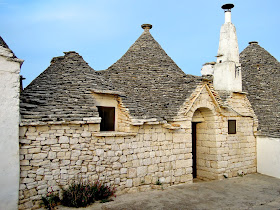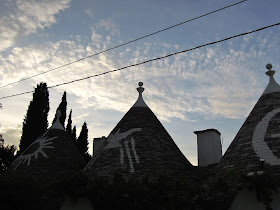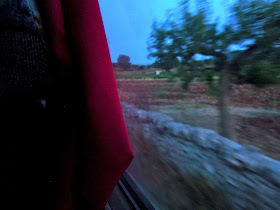The valleys were filled with vineyards separated by little stone walls constructed without any cement or mortar- just precisely piled stones called ciancarella. This was our first introduction to the strange and singular culture of this tiny hamlet in the hills. Before I go further I want to make a disclaimer that all historical information here is from my own rough translation of our tour guide's Italian, so don't cite me, but the history of this region is a bit ridiculous and immensely fascinating so I'll do my best!
From what I understand, the region around the town and comune of Alberobello (named after the Latin medieval name of the region, silva arboris belli) in the Murge hills was ruled by the Count of Conversano in the mid-14th century. The land was gifted to the count in recognition of his service during the crusades. Now the count did not want to pay taxes, and so he had his subjects build their houses out of the plentiful local ciancarella stones without using any mortar or cement. They did this so that when the King of Naples' men came to collect taxes, the houses could be quickly knocked over and destroyed so the area would seem uninhabited- hence no taxes. This is one of the most ridiculous historical facts I've ever heard, but apparently there are records of it working in 1644 when the king's tax inspectors came. Now you would likely be imprisoned for destroying one of these strange structures, called trulli and protected as a UNESCO World Heritage site.
This is the second city I've compared to Lord of the Rings, and I am aware of my geek status, but walking through the streets of the older historical center I kept thinking of the Hobbit houses in the Shire. So yeah, hand up if you know what I'm talking about.
After our brief little tour we had an hour to explore on our own. Six of us broke off for a quick espresso and then wandered up through the hills of the city through all the little white-washed, cone-topped trulli. I was amazed by the level of craftsmanship on some of the older homes especially- our guide Nella told us there are very few people left who can construct a trullo. It is a lost art, which is why this city is so treasured.
This made me think of one of my favorite aspects of Italy: as an art history student one learns about the value of art and architecture from the past, and many people can be extremely fastidious about the protection and maintenance of these monuments. As a possible future conservator I can often fall into this category, so what I love about the Italians is that even though they recognize the importance of the churches and paintings and houses that surround them, they aren't afraid to interact with them. Yes, the trulli are irreplaceable cultural monuments, but they're also all inhabited with shopkeepers and citizens who have no problem installing a washing machine or cooking spaghetti in their irreplaceable homes. For them art is a living thing, not meant to exist in a white-walled gallery behind layers of bulletproof glass. For god's sake though please don't get spaghetti sauce on the walls!
I'm wearing a super comfy sundress from Gap. It's sold out but similar one here. Sandals from Target, similar here and here. Bag from Fossil.
While we were walking around we could see that the roofs of some of the trulli had symbols painted on them, and almost all of them had a little ornament on the top. We passed a jewelry shop from which the owner beckoned us in and explained the meaning of these symbols. There are pre-christian, Christian, and Zodiacal symbols as well as those that indicate the occupation of the occupant (butcher, baker, candlestick maker...). Now of course the man's angle was to sell us sterling silver charms of the various symbols, but once he realized that we were American students, he abandoned his sales pitch and hurried to get his wife, who spoke wonderful English and wanted to practice with us! I talked with her for a bit about her dream to visit New York and her gorgeous crocheted silver wire jewelry. She also tried setting me up with her son, who attends University of Bologna! We met back up with the group, stopped in a shop for a bite of pizza, and got back on the bus for Ostuni.
I love riding in the coach. The seats are so comfortable, there's air conditioning, and the picturesque windows spoil us with views of the countryside as we ride from city to city. As we drove, Nella told us a bit about our next destination, Ostuni. Ostuni is called The White City and is quite a sight sitting on top of one of the tallest hills. We spent a good five minutes trying to help Nella remember the word "spaceship" and it really does look like one because of it's high circular white walls.
Ostuni is 25,000 years old, and was inhabited during the Paleolithic. Like Lecce it also has Messapic origins, and coincidentally it has the same patron, Sant'Oronzo. I don't know if I've mentioned this but this weekend was the Festival of Sant'Oronzo in Lecce and the entire city is like a big carnival- replete with rides and food vendors, music, and massive lighted structures throughout the streets and piazzas. Ostuni was no different!
We took another brief guided walk through the city, seeing the major churches and looking out over the walls of the city to the dark valley spotted with far-off lights. Then we had more free time to explore! My eye was caught by a little store we passed that was filled with white stone tablets etched with drawings of the city. I couldn't walk by without going inside so I stopped the group and peeked in, introducing myself to the owner and artist. He was such a friendly little man, and seemed completely unruffled by my obvious "I'm a student and thus poor and incapable of buying fine art" status and after giving me his info (in case I should win the lottery), he said, "Moorea, give me your camera and you go sit with your friends on the stairs. I will take your picture." We piled onto the stairs giggling and took one of my favorite pictures of the trip- the second one he made us hold the sign for his store! Ostuni Sulla Pietra, this man certainly knows how to advertise!
It's called Bottega d'Arte di Croci Sisinni, and Maestro Sisinni is so very talented and kind. You should really check him out if you have a chance. Also you could buy me four or five of them for my birthday! Website here. His site has pictures of all his work, but if you actually want to purchase something it might be best to email him at bottegadartecrocisisinni@hotmail.com.
We wandered through the gorgeously lit main piazza, stopped by a couple food vendors for crepes, olives, nuts, and dried fruit, and found the center of the fair with a little market and rides for the kids. In the park beside the fair there was an awesome tree that we felt obligated to climb, and when we returned to the piazza there was an opera concert in progress! We sat on the steps and munched on snacks, watching a bronze man interact with his lady and strings of bubbles floating in the air like a sky full of champagne. Walking back to the bus we indulged in some coconut banana smoothies and kebab sandwiches for the ride home.
It was another wonderful day!































































No comments:
Post a Comment